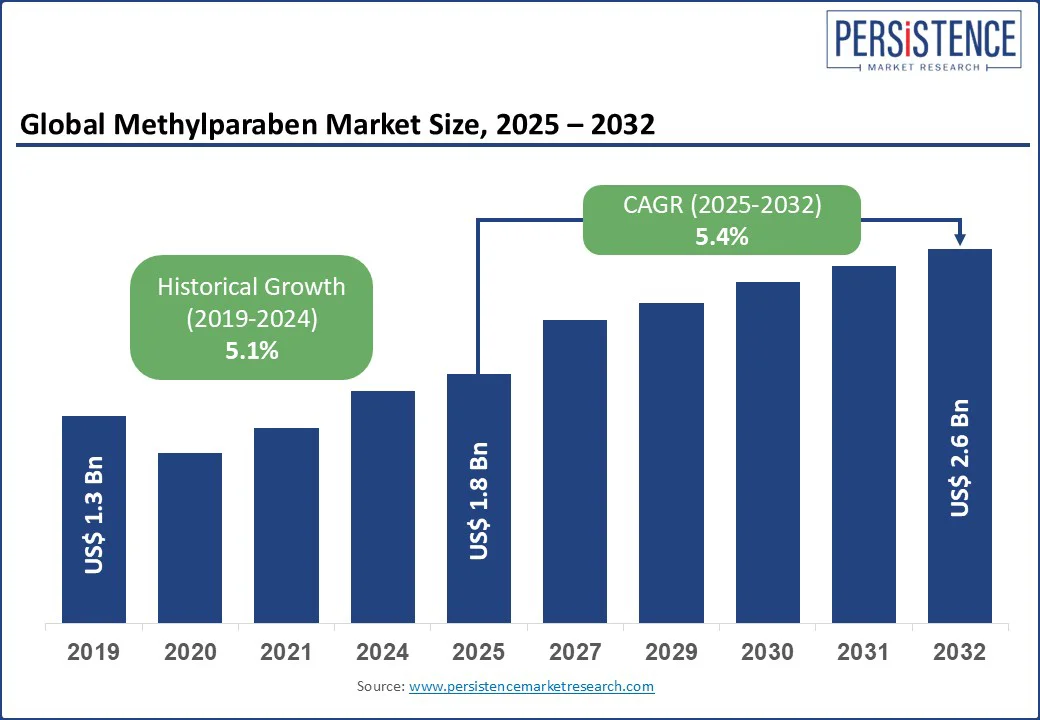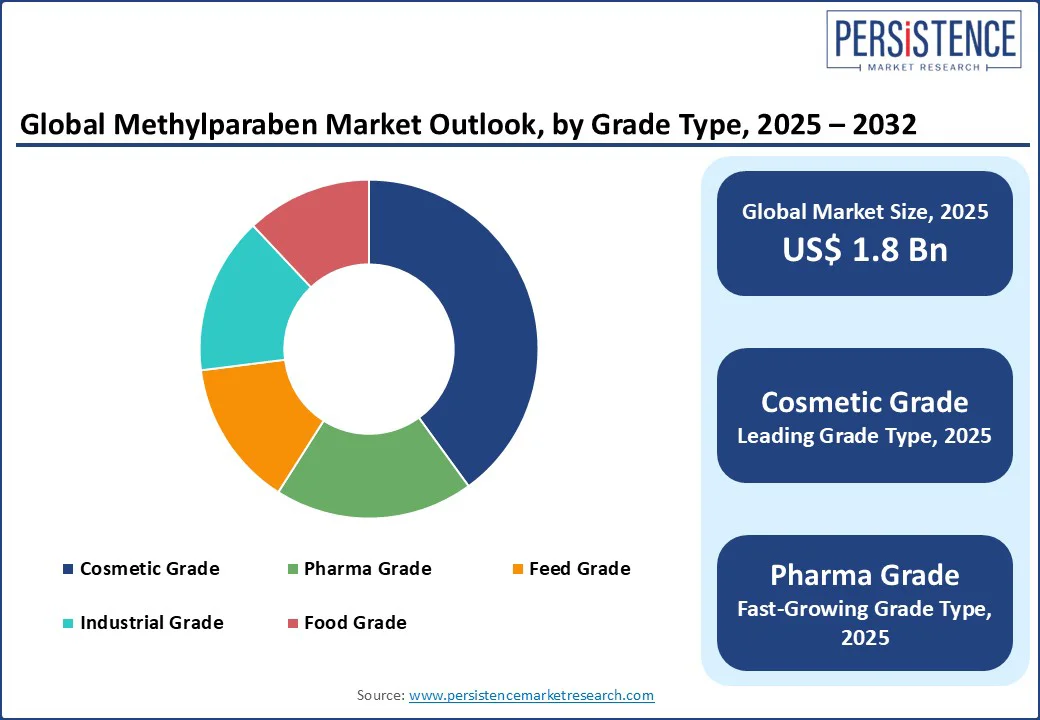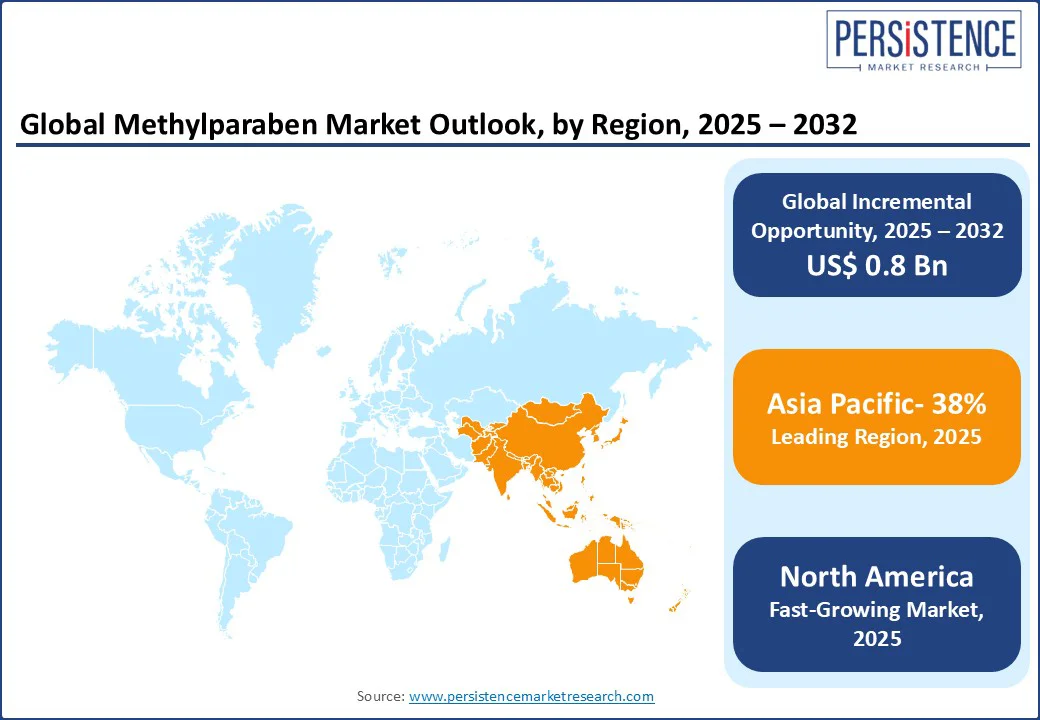ID: PMRREP4597| 188 Pages | 24 Aug 2025 | Format: PDF, Excel, PPT* | Chemicals and Materials

The global methylparaben market is likely to be valued at US$ 1.8 Bn in 2025, and is expected to reach US$ 2.6 Bn by 2032, growing at a CAGR of 5.4% during the forecast period from 2025 to 2032.
This growth is driven by rising demand in cosmetics, pharmaceuticals, and the food industries due to its effective antimicrobial and preservative properties. Growth is fueled by increasing consumer preference for longer shelf-life products, expanding personal care sectors, and urbanization. Additionally, technological advancements in formulation and growing awareness of product safety support market expansion despite regulatory scrutiny.
Key Industry Highlights

|
Global Market Attribute |
Key Insights |
|
Methylparaben Market Size (2019) |
US$ 1.3 Bn |
|
Methylparaben Market Size (2025E) |
US$ 1.8 Bn |
|
Market Value Forecast (2032F) |
US$ 2.6 Bn |
|
Projected Growth (CAGR 2025-2032) |
5.4% |
|
Historical Market Growth (CAGR 2019-2024) |
5.1% |
The cosmetics and personal care industry significantly drives the growth, owing to its widespread use as a preservative. Methylparaben is highly effective in preventing the growth of harmful microbes, extending the shelf life of products such as lotions, creams, shampoos, deodorants, and makeup. With rising consumer awareness about hygiene and product safety, brands increasingly rely on methylparaben to maintain quality and ensure compliance with global health standards. The shift towards convenient and long-lasting beauty solutions continues to push demand upward.
For instance, major skincare brands such as L'Oréal and Estée Lauder incorporate methylparaben in their formulations to maintain product stability across various climates. As the global personal care market expands-particularly in emerging economies-this trend supports the steady growth of the methylparaben industry. The increasing popularity of anti-aging and skincare routines further reinforces methylparaben’s crucial role in cosmetic product development.
The product faces challenges from consumer concerns over paraben safety and regulatory restrictions. In 2025, consumer preference for paraben-free products, driven by a 15% rise in demand for natural alternatives, impacts 20% of cosmetic sales, limiting market penetration. Stringent regulations, such as the EU’s ban on high-concentration parabens in certain products, increase compliance costs by 10%, affecting small-scale manufacturers.
Competition from alternative preservatives, such as phenoxyethanol, used in 30% of cosmetics, restricts market growth in eco-conscious regions. Raw material price volatility, with benzoic acid costs fluctuating by 12%, increases production costs by 8%. Supply chain disruptions, including a 10% shortage in high-purity raw materials, hinder production capacity, particularly for pharma-grade methylparaben, limiting growth in developing markets.
The shift toward sustainable and clean-label products presents significant opportunities. The global natural cosmetics market drives demand for low-toxicity methylparaben, with eco-friendly variants gaining 20% market share. Innovations in green chemistry, supported by US$ 4 Bn in R&D investments, target cosmetic and pharmaceutical applications, growing by 15% in 2025.
The rise of e-commerce, with global beauty sales growing at 12%, increases demand for methylparaben in personal care products by 18%. Emerging markets, with 2.5 billion urban consumers by 2030, offer untapped potential, particularly for cosmetic-grade methylparaben in skincare. Advances in formulation technologies, such as microencapsulation improving preservative efficacy by 15%, position methylparaben as a key ingredient in sustainable and high-performance products.
In 2025, powder methylparaben holds the largest market share at 38%, driven by its ease of formulation, cost-effectiveness, and high stability. These qualities make it ideal for use in a wide range of cosmetic and pharmaceutical products, including creams, tablets, and powders. With approximately 70% adoption in these industries, the powder form remains the most preferred due to its long shelf life, ease of handling, and compatibility with various formulations.
Meanwhile, liquid methylparaben is emerging as the fastest-growing form, supported by rising demand in pharmaceutical syrups and liquid cosmetics. Usage of the liquid form has increased by 15% in 2025, reflecting its growing popularity for fluid-based applications. Its ability to blend seamlessly in liquid formulations makes it a favored choice for manufacturers looking to enhance product performance and stability. This trend continues to boost the overall expansion across diverse end-use sectors.
In 2025, cosmetic-grade methylparaben commands the largest market share at 40%, driven by strong demand in skincare and haircare segments. With approximately 65% adoption across personal care products, its popularity stems from its effectiveness as a preservative and compatibility with a wide range of formulations. This grade continues to benefit from increasing consumer focus on hygiene, product longevity, and safe cosmetic ingredients, further fueling its market dominance.
Pharma-grade methylparaben is the fastest-growing segment, showing an 18% rise in demand in 2025, fueled by its critical role in drug formulation and preservation. The pharmaceutical sector increasingly relies on methylparaben to maintain stability and shelf life in various medicines. Meanwhile, food grade holds a 20% share, with feed and industrial grades each contributing 10%, primarily used in niche applications such as food preservation, livestock supplements, and industrial formulations, reinforcing the compound’s versatile role across industries.
In 2025, the cosmetics and personal care segment leads with a 45% market share, primarily driven by the rising demand for long-lasting skincare and hygiene products. Around 70% of lotions, shampoos, and other personal care items now include methylparaben for its proven preservative properties. Its steady growth rate of 5.2% reflects consistent consumer preference for safe, stable, and effective formulations that enhance shelf life and product quality.
Pharmaceuticals represent the fastest-growing end-use segment, with demand increasing by 20% in 2025. This growth is fueled by rising regulatory focus on drug safety and stability, prompting pharmaceutical companies to adopt methylparaben in a wide range of formulations.
Meanwhile, the food & beverages sector holds a 25% share, driven by its use in extending food shelf life, while other applications, including industrial products such as adhesives and coatings, contribute 10%, highlighting methylparaben’s versatile usage across sectors.

North America is emerging as the fastest-growing region in the methylparaben market, driven by increasing demand from cosmetics, personal care, and pharmaceutical sectors. With a rising preference for long-lasting skincare and hygiene products, the region shows strong adoption in lotions, shampoos, and drug formulations.
The U.S. leads the growth, supported by advanced R&D, strict quality regulations, and consumer awareness regarding product safety. In 2025, North America recorded over 30% of global pharmaceutical-grade methylparaben consumption, with the projection to maintain strong momentum. This trend reinforces the region’s leadership in preservative innovation and application diversity.
Europe maintains a significant share in the methylparaben market, driven by its well-established cosmetics, personal care, and pharmaceutical industries. With a strong regulatory framework and high consumer demand for safe, long-lasting products, the region continues to adopt methylparaben widely across skincare, haircare, and medicinal formulations.
Countries such as Germany, France, and the UK lead in product innovation and compliance with EU safety standards, contributing to stable market growth. In 2025, Europe accounted for over 25% of methylparaben demand, underscoring its role as a key market for high-quality preservative applications.
The Asia Pacific region leads the methylparaben market, holding a substantial 38% market share in 2025. Rapid urbanization, rising disposable incomes, and growing awareness of personal hygiene and skincare are key factors driving this dominance.
Countries such as China, India, and Japan are witnessing increased adoption of methylparaben in cosmetics, personal care, and pharmaceutical products. The expanding beauty and healthcare industries in this region fuel demand for preservatives that ensure product safety and longevity. Additionally, the surge in e-commerce and beauty product innovations further supports market growth, positioning Asia Pacific as a crucial hub for methylparaben consumption.

The global methylparaben market is characterized by intense competition among numerous manufacturers and suppliers striving to expand their market presence. Companies focus on innovation, product quality, and strategic partnerships to gain an edge.
Market dynamics are influenced by factors such as shifting consumer preferences, regulatory developments, and advancements in production technologies. Additionally, businesses are investing in sustainable and eco-friendly alternatives to meet rising demand. Overall, the competitive environment drives continuous improvement and diversification within the industry.
The methylparaben market is projected to reach US$ 1.8 Bn in 2025, driven by demand in cosmetics and pharmaceuticals.
Key drivers include cosmetics industry growth, pharmaceutical safety needs, and clean-label trends.
The methylparaben market is expected to grow at a CAGR of 5.4% from 2025 to 2032, reaching US$ 2.6 Bn.
Opportunities include eco-friendly preservatives, e-commerce growth, and pharmaceutical applications.
Leading players include Merck KGaA, Clariant, Ami Organics Ltd., and Novapehene Specialities Pvt. Ltd.
|
Report Attribute |
Details |
|
Historical Data/Actuals |
2019 - 2024 |
|
Forecast Period |
2025 - 2032 |
|
Market Analysis Units |
Value: US$ Bn |
|
Geographical Coverage |
|
|
Segmental Coverage |
|
|
Competitive Analysis |
|
|
Report Highlights |
|
|
Customization and Pricing |
Available upon request |
By Foam Type
By Grade Type
By End-use
By Region
Delivery Timelines
For more information on this report and its delivery timelines please get in touch with our sales team.
About Author